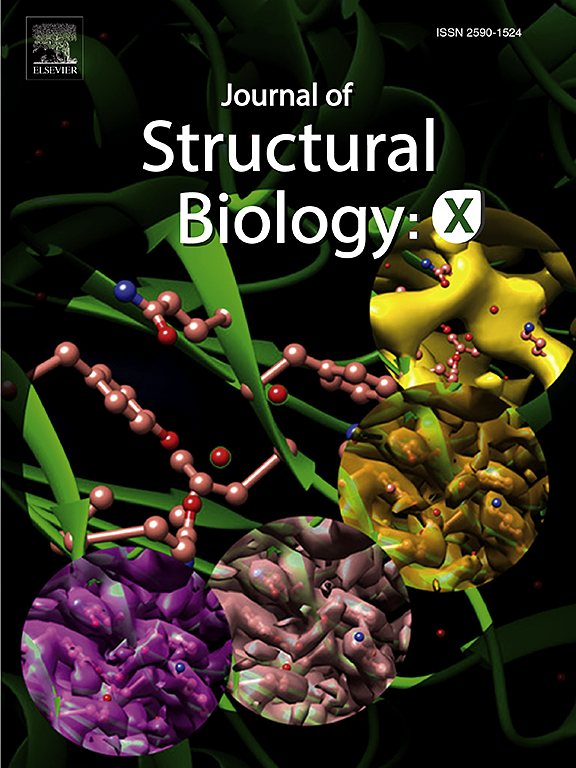小鼠淀粉样蛋白的 SAXS 发现了一种在 pH 值 5.0 到 8.0 之间持续存在的二聚体物种。
IF 2.7
3区 生物学
Q3 BIOCHEMISTRY & MOLECULAR BIOLOGY
引用次数: 0
摘要
amelogenin是哺乳动物牙釉质形成所必需的一种内在无序蛋白。利用同步加速器上最新、最先进的小角 X 射线散射(SAXS)功能和计算模型,我们重新研究了鼠淀粉样蛋白的四元结构随 pH 值和 Ser-16 处磷酸化的变化。SAXS 数据显示,在极端 pH 值下,淀粉样球蛋白在 pH 值为 3.0 时为扩展单体(Rg = 38.4 Å),在 pH 值为 8.0 时为纳米球(Rg = 84.0 Å),这与之前的多次观察结果一致。在 pH 值为 5.0 及以上时,没有证据表明存在大量单体物种。相反,在 pH 值为 5.0 时,80% 的单体是异源二聚体,而在 pH 值为 5.5 时,这一比例增加到 100%。在所有 pH > 5 的条件下,都能观察到二聚物群与 pH < 6.5 时的五聚物群和 pH 8.0 时的纳米球处于动态平衡状态。在 pH 值为 8.0 时,40% 的淀粉样蛋白仍处于二聚体状态。总的来说,丝氨酸-16 磷酸化似乎能适度稳定二聚体物种的数量。本文章由计算机程序翻译,如有差异,请以英文原文为准。

SAXS of murine amelogenin identifies a persistent dimeric species from pH 5.0 to 8.0
Amelogenin is an intrinsically disordered protein essential to tooth enamel formation in mammals. Using advanced small angle X-ray scattering (SAXS) capabilities at synchrotrons and computational models, we revisited measuring the quaternary structure of murine amelogenin as a function of pH and phosphorylation at serine-16. The SAXS data shows that at the pH extremes, amelogenin exists as an extended monomer at pH 3.0 (Rg = 38.4 Å) and nanospheres at pH 8.0 (Rg = 84.0 Å), consistent with multiple previous observations. At pH 5.0 and above there was no evidence for a significant population of monomeric species. Instead, at pH 5.0, ∼80 % of the population is a heterogenous dimeric species that increases to ∼100 % at pH 5.5. The dimer population was observed at all pH > 5 conditions in dynamic equilibrium with a species in the pentamer range at pH < 6.5 and nanospheres at pH 8.0. At pH 8.0, ∼40 % of the amelogenin remained in the dimeric state. In general, serine-16 phosphorylation of amelogenin appears to modestly stabilize the population of the dimeric species.
求助全文
通过发布文献求助,成功后即可免费获取论文全文。
去求助
来源期刊

Journal of structural biology
生物-生化与分子生物学
CiteScore
6.30
自引率
3.30%
发文量
88
审稿时长
65 days
期刊介绍:
Journal of Structural Biology (JSB) has an open access mirror journal, the Journal of Structural Biology: X (JSBX), sharing the same aims and scope, editorial team, submission system and rigorous peer review. Since both journals share the same editorial system, you may submit your manuscript via either journal homepage. You will be prompted during submission (and revision) to choose in which to publish your article. The editors and reviewers are not aware of the choice you made until the article has been published online. JSB and JSBX publish papers dealing with the structural analysis of living material at every level of organization by all methods that lead to an understanding of biological function in terms of molecular and supermolecular structure.
Techniques covered include:
• Light microscopy including confocal microscopy
• All types of electron microscopy
• X-ray diffraction
• Nuclear magnetic resonance
• Scanning force microscopy, scanning probe microscopy, and tunneling microscopy
• Digital image processing
• Computational insights into structure
 求助内容:
求助内容: 应助结果提醒方式:
应助结果提醒方式:


